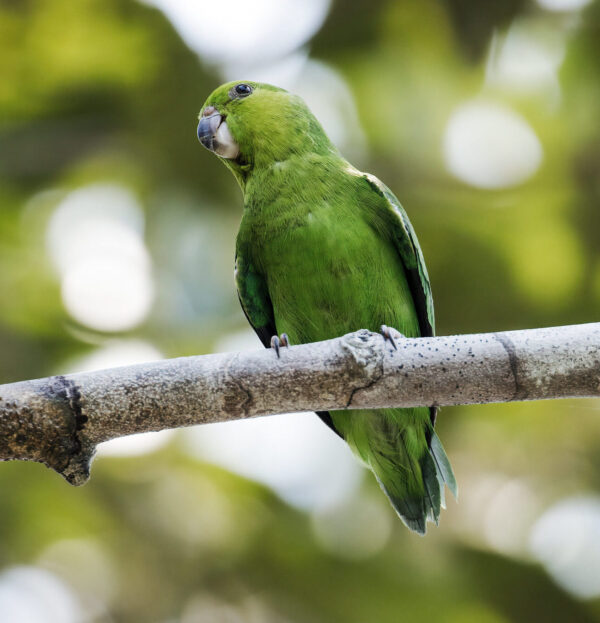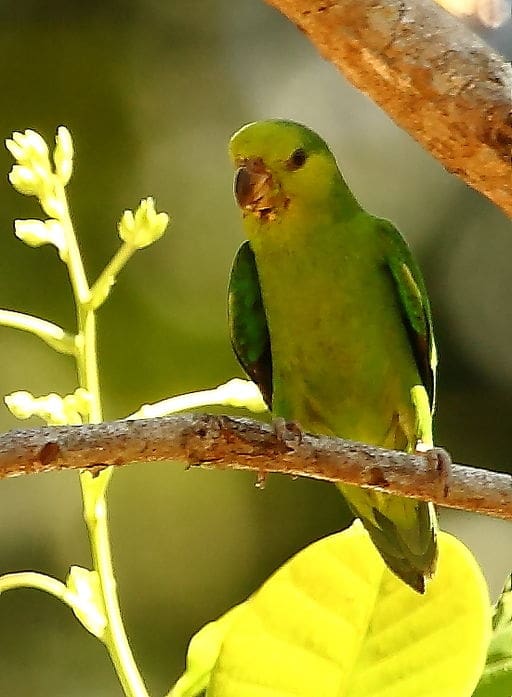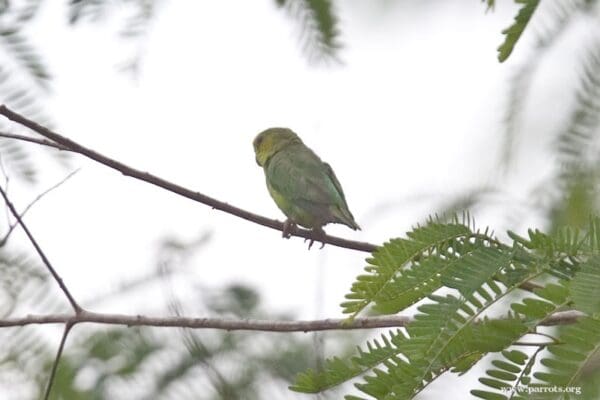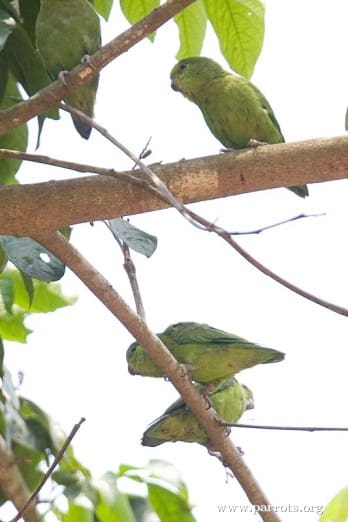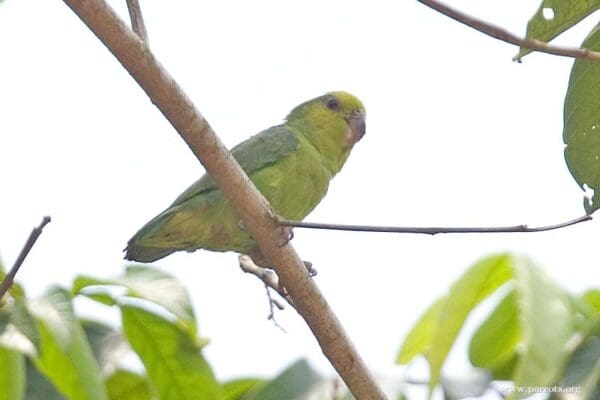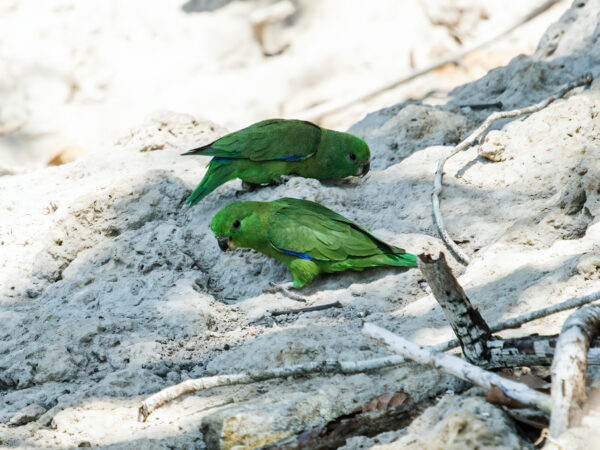Dusky-billed Parrotlet
Also known as:
Sclater's Parrotlet
Also known as:
Sclater's Parrotlet
![© Nick Athanas [CC BY-NC-ND 2.0] via Flickr A wild Dusky-billed Parrotlet perches on a limb](https://parrots.org/wp-content/uploads/1990/04/Dusky-billed-Parrotlet-Nick-Athanas-e1733260662228-100x100.jpg)
![© Jan Willem Broekema [CC BY-NC-SA 2.0] via Flickr A wild Dusky-billed Parrotlet peeks out of a nest cavity](https://parrots.org/wp-content/uploads/2023/01/wpt_Dusky-billed-Parrotlet_1367-8-100x100.jpg)
![© Vince Smith [CC BY-NC-SA 2.0] via Flickr Wild Dusky-headed Conures and Dusky-billed Parrotlets perch together](https://parrots.org/wp-content/uploads/2023/01/wpt_Dusky-billed-Parrotlet_1367-6-100x100.jpg)
![© Hector Bottai [CC BY-SA 3.0] via Wikimedia Commons A wild Dusky-billed Parrotlet perches on a branch](https://parrots.org/wp-content/uploads/2023/01/wpt_Dusky-billed-Parrotlet_1367-3-100x100.jpg)
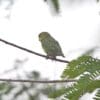
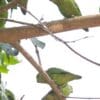
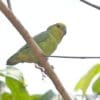
![© Nick Athanas [CC BY-NC-ND 2.0] via Flickr A wild Dusky-billed Parrotlet perches in a tree](https://parrots.org/wp-content/uploads/1990/04/Dusky-billed-Parrotlet3-Nick-Athanas-100x100.jpg)
![© Nick Athanas [CC BY-NC-ND 2.0] via Flickr Wild Dusky-billed Parrotlets forage in dirt](https://parrots.org/wp-content/uploads/1990/04/Dusky-billed-Parrotlet-2-Nick-Athanas-100x100.jpg)
DID YOU KNOW?
The Dusky-billed Parrotlet takes mineral soil from clay river banks alongside other parrots. This is called geophagy.

Forpus

modestus
Size:
12.5 cm (4.8 in)
Weight:
Probably 30-35 g (1-1.2 oz)
Subspecies including nominate:
two: F.m. modestus, F.m. eidos
Colour Adult:
F.m. modestus: Male-dark green in colour; emerald green forehead and cheeks; purple/blue lower back and rump; purple/blue primary and secondary coverts, secondary feathers, and underwing coverts; outer webs of inner primary feathers purple/blue at bases. Upper mandible dark grey with horn-coloured base, lower mandible horn-coloured. Eye brown. Female-as in male but blue markings replaced by green; green/yellow forehead, forecrown and cheeks.
F.m. eidos: Male-paler green in colour; purple/blue on lower back and rump paler. Female-paler green in colour, particularly on breast.
Colour Juvenile:
In general duller than adults; in young male blue markings are mixed with green.
Call:
Calls are described as distinctive; high-pitched notes or soft, wheezing sounds in flight or while perched.
More Information:
Content Sources:
CITES
BirdLife International
Cornell Lab of Ornithology/Birds of the World
Parrots: A Guide to Parrots of the World, Juniper and Parr, 1998
Parrots of the World, Forshaw and Cooper, 1977. 2010 edition
Lexicon of Parrots, Thomas Arndt.
Parrots of the World, Forshaw, 2006.
Parrots in Aviculture, Low, 1992.
Captive Status:
Uncommon but seen in the European Union.
Longevity:
Up to 25 yrs.
Housing:
Walk-in enclosure minimum length 2.1 m (7 ft) or indoor aviary length 1.8 m (6 ft).
Diet:
As in other parrotlets – small seed mix such as: canary, millet and smaller amounts of oats, buckwheat, safflower and a little hemp; limited sunflower seed; spray millet; green leaves such as: Swiss chard, lettuce, sowthistle, dandelion, chickweed; seeding grasses; rearing food made from: hard-boiled egg, wholegrain bread and carrot, all ground to crumbly consistency; complete pellet.
Enrichment:
Provide overhead misters or shallow bowls for bathing. Are moderate chewers, so provide bird-safe, unsprayed flowering, fir, pine or willow branches, heat sterilized pine cones, wooden block toys, vegetable tanned leather toys, puzzle toys, foraging toys, swings and ladders.
Nest Box Size:
Vertical box 6″ x 6″ x 6″ (15 cm x 15 cm x 15 cm).
Clutch Size:
Probably 3-6.
Fledging Age:
5-6 weeks
Hatch Weight:
—
Peak Weight:
—
Weaning Weight:
—
World Population:
Unknown but reported as fairly common, decreasing.
IUCN Red List Status:
Least Concern
CITES Listing:
Appendix II
Threat Summary:
Evidence exists for this species’ decline in E Amazonia and possibly an increase in Colombia. Not generally found in trade. Is considered to have a medium dependency on forest habitat, and tree cover is estimated to have declined by 4.4% within its mapped range over the past 10 years. Therefore, as a precautionary measure, it is tentatively suspected that this may have led to a 1-19% decline in the species’ population over the same time frame.
Range:
F.m. modestus: From Belem, Para, N Brazil, west to SE Colombia, south to E Peru, W Brazil and N Bolivia.
F.m. eidos: French Guiana, W Guyana, E and S Venezuela and N Brazil to E Colombia.
Habitat:
Found up to 1000 m (3280 ft) in lowland tropical rainforest in clearings, forest edge, riparian growth, varzea, secondary habitats and savanna.
Wild Diet:
Diet consists of Cecropia fruits, seeds, berries, buds and blossoms.
Ecology and Behaviour:
Found in flocks of 100 or more individuals outside breeding season. Nests in tree cavity. Conspicuous while moving amongst foliage of canopy.
Clutch and Egg Size:
Unknown number of spherical to elliptical eggs, 18.0 x 15.0 mm (0.7 x 0.6 in).
Breeding Season:
Likely July. Nest is presumably in tree hollow.
Related Links:
—
